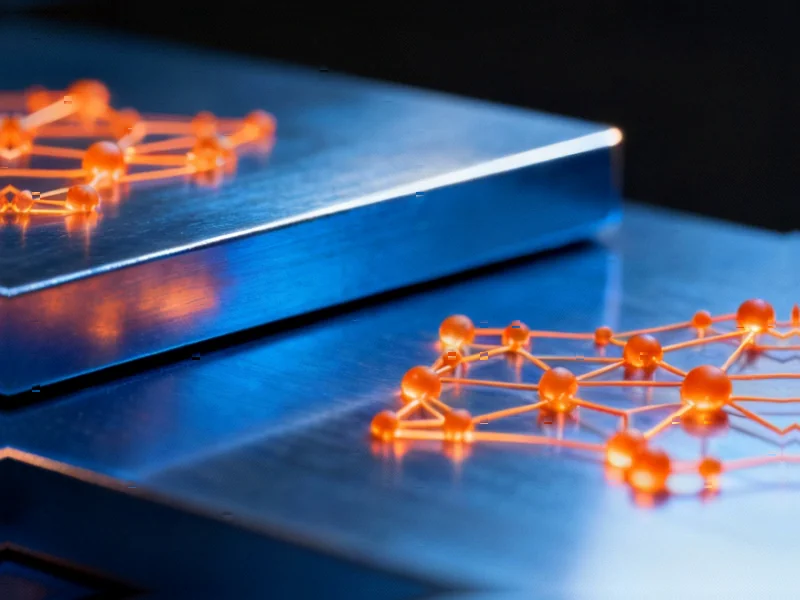Machine Learning Revolutionizes Superalloy Development
Researchers have developed an innovative explainable machine learning framework that reportedly enables dual-objective optimization of γ’ phase characteristics in cobalt-based superalloys, according to recent findings published in npj Computational Materials. The breakthrough methodology combines advanced data augmentation techniques with interpretable AI to design alloys with simultaneously low coarsening rates and high volume fractions of the strengthening γ’ phase.
Table of Contents
- Machine Learning Revolutionizes Superalloy Development
- Overcoming Data Limitations Through Multi-Fidelity Augmentation
- Ensemble Learning Models Deliver Robust Predictions
- Addressing Data Imbalance with SMOGN Enhancement
- Interpretable AI Guides Novel Alloy Design
- Broader Implications for Materials Science
Overcoming Data Limitations Through Multi-Fidelity Augmentation
Sources indicate the research team faced significant challenges with limited experimental data, particularly for the γ’ phase coarsening rate constant (K), where only 132 samples were available. To address this constraint, analysts employed two sophisticated data generation approaches: Markov Chain Monte Carlo sampling and Wasserstein Generative Adversarial Networks with Gradient Penalty. The report states these methods generated approximately 1,600 synthetic samples that were subsequently validated using Thermo-Calc software simulations.
The hierarchical augmentation strategy proved particularly effective for predicting coarsening rates, where the original model trained exclusively on experimental data achieved limited performance with an R² of 0.593. According to the analysis, integrating WGAN-GP-generated samples with experimental data substantially improved predictive accuracy, reducing mean absolute error from 34.218 to 13.631 nm·s⁻¹ while maintaining reasonable correlation coefficients.
Ensemble Learning Models Deliver Robust Predictions
Researchers reportedly evaluated four ensemble learning algorithms—Random Forest, Gradient Boosted Decision Trees, AdaBoost, and XGBoost—for predicting both coarsening rates and volume fractions. The XGBoost model consistently outperformed other approaches, particularly for volume fraction prediction where it achieved a cross-validated R of 0.864 ± 0.043. External validation using ten independent experimental samples further confirmed the model’s reliability, achieving an R of 0.800.
Addressing Data Imbalance with SMOGN Enhancement
The most significant improvements emerged when researchers applied the Synthetic Minority Oversampling with Gaussian Noise algorithm to address the long-tailed distribution of coarsening rate data. Analysis suggests that SMOGN augmentation dramatically enhanced model performance, boosting R² to 0.924 ± 0.037 while reducing mean absolute error to 12.641 ± 3.222 nm·s⁻¹. External validation confirmed these improvements, with the enhanced model achieving an R of 0.862 on independent test samples.
Interpretable AI Guides Novel Alloy Design
Beyond predictive modeling, the research team employed SHAP analysis to interpret the black-box nature of machine learning models, quantifying individual feature contributions and elucidating feature interactions. Guided by these insights, sources indicate researchers designed and validated novel cobalt-based superalloy compositions through phase diagram calculations and experimental evaluations.
The report states this approach successfully identified optimal composition sets that simultaneously deliver relatively low γ’ phase coarsening rates and high γ’ phase volume fractions while satisfying multiple other key performance criteria. This dual-objective optimization represents a significant advancement in superalloy design methodology, potentially accelerating development of materials for extreme environment applications.
Broader Implications for Materials Science
The demonstrated framework adapts to varying levels of data availability, offering a flexible approach for materials informatics. For targets with limited experimental data, the methodology first introduces medium-fidelity simulated data to enrich dataset diversity, followed by low-fidelity SMOGN-generated samples to mitigate target imbalance. For well-characterized properties, SMOGN augmentation alone provides substantial improvements.
This research reportedly establishes a new paradigm for diffusion-informed materials design, combining computational thermodynamics, machine learning, and interpretable AI to navigate complex composition-property relationships in multi-component alloy systems. The successful integration of data augmentation techniques with physics-based validation suggests similar approaches could benefit other materials development challenges where experimental data remains scarce.
Related Articles You May Find Interesting
- Halliburton Makes Strategic Power Market Move with VoltaGrid Investment
- Europe’s Aerospace Giants Forge Historic Alliance to Challenge SpaceX Dominance
- This startup is about to conduct the biggest real-world test of aluminum as a ze
- Tesla’s AI Ambitions and Leadership Stability: The Musk Factor in Q3 Earnings an
- Building AI-Powered Telecom Analytics with Spring AI MCP: A Complete Implementat
References
- http://en.wikipedia.org/wiki/Data_augmentation
- http://en.wikipedia.org/wiki/XGBoost
- http://en.wikipedia.org/wiki/Ensemble_learning
- http://en.wikipedia.org/wiki/Mean_absolute_error
- http://en.wikipedia.org/wiki/Mass_diffusivity
This article aggregates information from publicly available sources. All trademarks and copyrights belong to their respective owners.
Note: Featured image is for illustrative purposes only and does not represent any specific product, service, or entity mentioned in this article.



